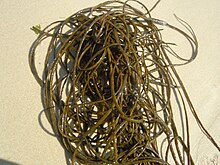Sea string
| Sea string | ||||||||||||
|---|---|---|---|---|---|---|---|---|---|---|---|---|

Sea string ( Chorda filum ) |
||||||||||||
| Systematics | ||||||||||||
|
||||||||||||
| Scientific name | ||||||||||||
| Notochord filum | ||||||||||||
| ( L. ) Stackh. |
The sea string ( Chorda filum ), also known as the common sea string, is a cord-shaped brown alga from the Laminariales group . It is widespread on the coasts of the northern hemisphere and is also found in the North Sea and Baltic Sea.
description
The sea string is a dark to olive brown seaweed with a string-like shape. The thallus is attached to the stony ground with a small, round adhesive disc. From it arise several unbranched, round cords that can be two to six (rarely up to ten) meters long. Their diameter is two to five millimeters and narrows towards the base and towards the end. Young cords are dense and short, colorless or hairy yellowish. The older, bare cords are hollow inside and filled with air, which gives the thallus buoyancy and keeps it upright in the water. The cords are often wound around each other like ropes.
Development cycle
The visible seaweed is the sporophyte . It appears in spring, in the North Sea from around April, and lives until mid-September. The spores are formed from the beginning of July. The sporangia , together with the paraphyses , then surround almost all of the cords as a layer, only the lowest section remains free. As with all Laminariales , the generation of gametophytes consists of microscopic cell threads.
Occurrence
The sea string is widespread on the coasts of the northern hemisphere in cold and temperate climates . In the north and north-east Atlantic it occurs from Greenland to the Canary Islands . It was found in the North Sea near Heligoland and in the North and West Frisian Wadden Sea , as well as in the western Baltic Sea . It also occurs in places in the Mediterranean . In the Northwest Atlantic, their area extends from Labrador to New Jersey . In the Pacific , it is common on the coasts of Japan , China, and Alaska .
The sea string grows on small stones, gravel or shells just below the low water line (up to a maximum of five meters depth) and in the lowest intertidal zone . At low tide you can see their tangled strands flooding on the surface of the water. Occasionally it also settles epiphytically on other algae. The sea string prefers more sheltered bays and lacks coastlines that are exposed to strong waves. In the event of a storm, it can be shipped to quieter locations together with its documents. It tolerates lower salinity, so it can also thrive in estuaries and the Baltic Sea.
ecology
The sea string is often overgrown with epiphytes , including the red algae Polysiphonia violacea and red horned wrack ( Ceramium virgatum ), the green algae sea lettuce ( Ulva lactuca ) and wavy intestinal seaweed ( Ulva linza ) and the brown alga Hincksia granulosa .
Systematics
The species was first described in 1753 by Carl von Linné in Species Plantarum under the name Fucus filum . The English botanist John Stackhouse placed the species in the genus Chorda in 1797 (In: Nereis britannica ). Chorda filum is the type species of this genus.
Synonyms are Fucus filum L., Ceramium filum (L.) RHWiggers, Chordaria filum (L.) C. Agardh, Scytosiphon filum (L.) C. Agardh , Chondrus filum (L.) JV Lamouroux and Fucus filiformis Strøm. The hairy juvenile forms have previously been described as a distinct taxa ( chorda filum var. Thrix WJHooker, notochord Filum var. Subtomentosa Areschoug, notochord Filum f. Subtomentosa (Areschoug) Kjellman), they are also interchangeably.
swell
- Wolfram Braune: marine algae. A color guide to the common benthic green, brown and red algae of the world's oceans . Ruggell: Gantner, 2008, ISBN 978-3-906166-69-8 , pp. 186-189. (for the sections Description and Occurrence)
Individual evidence
- ↑ a b c d P. Kornmann, PH Sahling: Sea algae from Helgoland - Benthic green, brown and red algae. Biological Institute Helgoland, Hamburg 1983, ISSN 0017-9957 , p. 150.
- ↑ a b c Michael Guiry: The Seaweed Site: information on marine algae: Chorda filum , accessed on November 6, 2014.
- ↑ Dirk Schories, Uwe Selig, Hendrik Schubert: Species and synonym list of the German marine macroalgae based on historical and recent records (list of species and synomes of macroalgae in German coastal waters - evaluation of historical and recent findings) . In: Rostock. Marine biologist Contribution , Issue 21, 2009, p. 54. PDF file
- ^ A b Nicola White, Stefan Kraan: BIOTIC Species Information for Chorda filum . MarLIN (Marine Life Information Network). Marine Biological Association of the United Kingdom, accessed November 7, 2014.
- ↑ Carl von Linné: Species Plantarum. Volume 2, Lars Salvius, Stockholm, 1753, p. 1162. Digitized
- ↑ a b Michael D. Guiry in Michael D. Guiry, GM Guiry: Chorda filum - In: Algaebase - World-wide electronic publication, National University of Ireland, Galway, accessed November 6, 2014.
